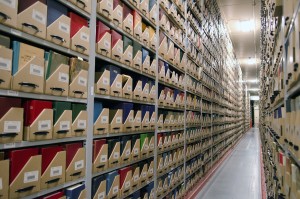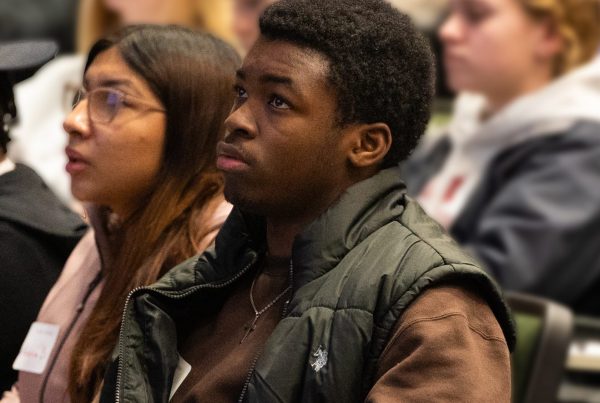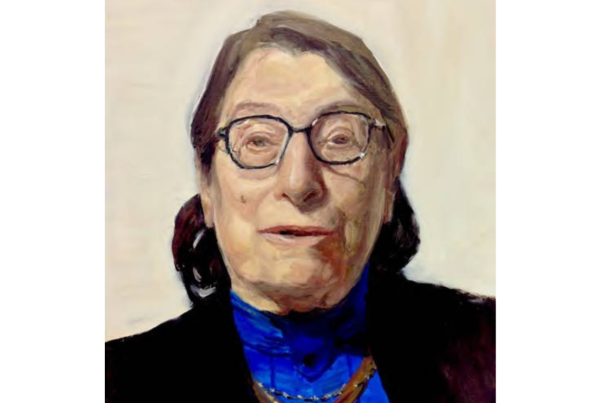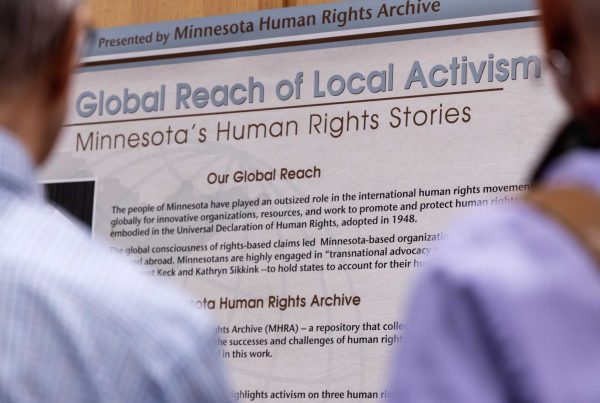By Kate Dietrick
Assistant Archivist, Upper Midwest Jewish Archives
 When entering the library profession, a unifying goal we all have in common is the strong desire to help people. And that is why I hate uttering six words that I find myself saying every now and again.
When entering the library profession, a unifying goal we all have in common is the strong desire to help people. And that is why I hate uttering six words that I find myself saying every now and again.
Patron: “Can I check this book out?”
Me: “We’re not that kind of library.”
Patron: “I’m late for class, is there somewhere in this building that I can print this?”
Me: “We’re not that kind of library.”
Patron: “Oh, I just want to look through the books you have here on the shelf.”
Me: “We’re not that kind of library.”
And you’re perusing the shelves of what is actually my office, sir, please, this room isn’t a public stacks of books.
Home to Archives and Special Collections
I work in Elmer L. Andersen Library which, yes, is a library. But this is where Archives and Special Collections lives: we of the closed stacks, we of the non-circulating materials. With rules upon rules—no drinks, no pens, one folder of materials at a time, nothing leaves the reading room—I often worry that we may be perceived as gate-keepers, setting up barriers for patrons to come and use our collections. Yet you would be hard pressed to find a group of librarians, curators, and archivists who actively encourage visitors more than the staff in Andersen Library. But how do you encourage discoverability of your materials when your patrons can’t actually browse the shelves and discover themselves?
We have our reasons for being not that kind of library. Archives and Special Collections hold unique and priceless materials—from one of a kind illustrations for children’s books to records of international social service adoptions to unclassified government documents detailing Navy computer equipment.
Home to the caverns
Because of their unique nature, we take extra care of our materials by keeping them in underground caverns, thus making this area closed off to the public. The environment in the caverns is more easily controllable—won’t heat up with the sun, won’t cool down during a snowstorm. The temperature is kept at a cool 62 degrees Fahrenheit with a relative humidity of 45-50 percent year round. Eighty-two feet below the ground, each cavern (of which there are two currently, with room for more) is 680 feet long, 65 feet wide, and 23 feet high. Each one is therefore the length of two football fields; there would be room to park 250 cars in each.
For our purposes, the capacity of one cavern that holds books with the Minnesota Library Access Center is 1.4 million volumes, while the other cavern for Archives and Special Collections holds 93,000 cubic feet. To give you an idea of how large that is, one records carton box measures 1.15 cubic feet. In other words, that’s a lot of boxes.
With the stacks rising to the top of the ceiling—23 feet high—we use stock pickers to access the boxes on the upper most shelves. Strapped in to a harness, hoisted up in the air, one begins to understand just why this library is a little bit different than the one you stroll through to find what you’re looking for. (For a peek into the caverns, check out the video from the Performing Arts Archives, which is currently raising funds to help restore and preserve the Guthrie Theater costume bibles.)
Home to the community
Yet despite our closed stacks, we encourage and embrace wide use of our collections to the community at large. We meet our researchers and provide one-on-one service to get you the materials you need. Since September 2014, Andersen Library has welcomed nearly 1,300 researchers into our reading room. We have also conducted nearly 200 instruction events to students and community members, with nearly 3,900 attendees.
We also promote discoverability of digitized materials from our collections—from repositories such as Umbra: Search African American History to online exhibits such as Olaus Magnus: 16th Century Map of Scandinavia. The University of Minnesota UMedia Archive is brimming with digitized materials across all the different collections—from pulp novel covers to war posters.
What we lack in study nooks and couches we make up for in unique and fascinating materials that can’t be found elsewhere. Come in and discover the extraordinary.
April 12 through 18 is National Library Week
The Libraries want to help you prepare for finals. Stop by one of three pop-ups during National Library Week (April 12 to 18) for giveaways and to share your study tips!
- West side of the Washington footbridge, Monday April 13 from 11:00 a.m. to 2:00 p.m.
- Paul Student Center on Monday, April 13 from 11:00 a.m. to 2:00 p.m.
- Coffman Union on Tuesday, April 14 from 11:00 a.m. to 2:00 p.m.




